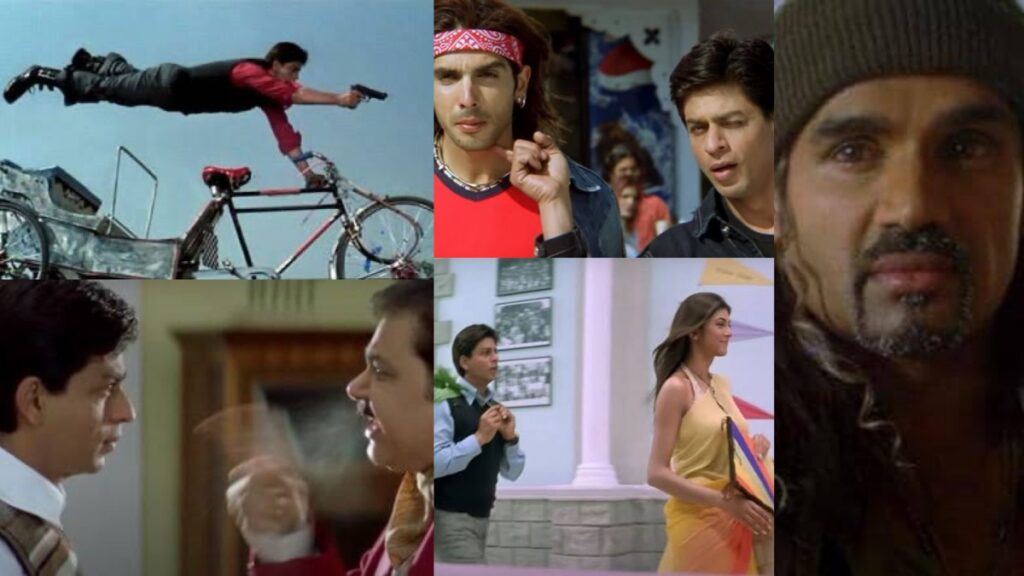In the tapestry of Bollywood’s cinematic landscape, Farah Khan’s “Main Hoon Na” emerges as a vibrant mosaic, blending elements of action, romance, comedy, and social commentary into a captivating narrative that transcends boundaries of time and culture. As an avid film watcher, I find myself drawn to the film’s ability to entertain, enlighten, and inspire in equal measure.
“Main Hoon Na” (2004) follows Major Ram, an Indian Army officer tasked with protecting the daughter of a general while infiltrating her college in the backdrop of a peace mission between India and Pakistan, threatened to be jeopardised by a radical named Raghavan. Amidst his mission, Ram reconciles with his estranged stepbrother, confronts personal demons, and discovers hidden family ties. Along the way, he forges friendships, navigates romance, and faces off against adversaries, blending action, comedy, and drama. As secrets unravel and emotions run high, Ram’s loyalty to his duty and his heart are put to the test. Through a series of exhilarating events and heartfelt moments, the film explores themes of love, sacrifice, and the power of redemption.

One of the film’s most striking qualities is its celebration of diversity and inclusivity, themes that resonate profoundly in today’s globalized world. Through its portrayal of characters from diverse backgrounds and its exploration of themes such as communal harmony and the human experience, “Main Hoon Na” speaks to the universal values that connect us all. In an era marked by division and polarization, the film’s message of unity and understanding serves as a powerful reminder of our shared humanity.

Central to the film’s enduring appeal are its richly drawn characters, brought to life by a talented ensemble cast. Shah Rukh Khan delivers a tour de force performance as Major Ram, infusing the character with depth, charisma, and emotional resonance. The ensemble cast that boasts of actors like Suniel Shetty, Boman Irani, Satish Shah, Kiron Kher, Bindu, Naseerudin Shah (in a cameo) and Sushmita Sen was pivotal to the film’s success. The film’s young leads were Zayed Khan and Amrita Rao. The chemistry between the characters, whether it’s the playful banter between Ram and Lucky or the tender moments shared between Ram and Chandni, adds layers of complexity to the narrative, elevating it beyond the confines of traditional masala cinema.

Music plays a huge role in the popularity of “Main Hoon Na”. Composed by Anu Malik and lyrics by Javed Akhtar created magic as each song of the album became chartbusters. Even after 20 years, when you listen to it today, the soundtrack captures the essence of the movie’s emotions and themes, enhancing pivotal moments and adding depth to the narrative. Iconic songs like “Tumse Milke Dil Ka” and “Main Hoon Na” have become timeless classics, while tracks like “Chale Jaise Hawaien” and “Gori Gori” are known for their catchy beats and lively choreography. The music of “Main Hoon Na” is a integral part of its charm, leaving a lasting impression on audiences.

Farah Khan, while making her first film as a director, turned it into a love letter to the Hindi films. She took countless inspirations from various popular films and fiction alike. Her leads are named Ram Prasad and Laxman Prasad, which is a homage to Hrishikesh Mukherjee’s ‘Golmaal’. The obvious good vs bad conflict of two brothers against a common enemy was from Ramayana where Ram and Ravana are in tussle. Major Ram swerves from the volley of spitballs, like Neo from Matrix. In fact he jumps and shoots from the top of a rickshaw, tumbling down from a higher point, while the Mission Impossible OST plays in the background. The film has multiple references to RD Burman songs and ‘Sholay’. In fact the sequence that has Lucky cutting off his long locks, was inspired from an old Ala detergent ad, featuring Shahid Kapoor. Each characters of the film were modeled impeccably to suit the scenario. The absent minded goofball Principal, the spitting Professor, the crochet poking old Mrs Kakkar, the villain in disguise Raghavan, every character has become memorable for film lovers. The film even has a blink-and-miss guest appearance by Tabu, looking befuddled while SRK makes weird dance moves on the school playground.

What truly sets “Main Hoon Na” apart is its ability to weave together entertainment and social commentary seamlessly. Beneath its glossy exterior lies a thought-provoking exploration of themes such as identity, family dynamics, and the pursuit of justice. The film’s nuanced approach to these issues sparks important conversations and prompts viewers to reflect on their own beliefs and values. Farah Khan’s vision, coupled with the stellar performances of the cast and the film’s technical prowess, ensures that it will always remain a classic in the masala film genre – a testament to the enduring power of cinema to entertain, enlighten, and inspire.
It’s been 20 years.. go and catch a glimpse of the ever entertaining “Main Hoon Na” with Anu Malik, in his glorious raspy voice humming in your ears –
Dum Tara, Dum Tara, Dum Tara, Dum Tara.. Dum!

